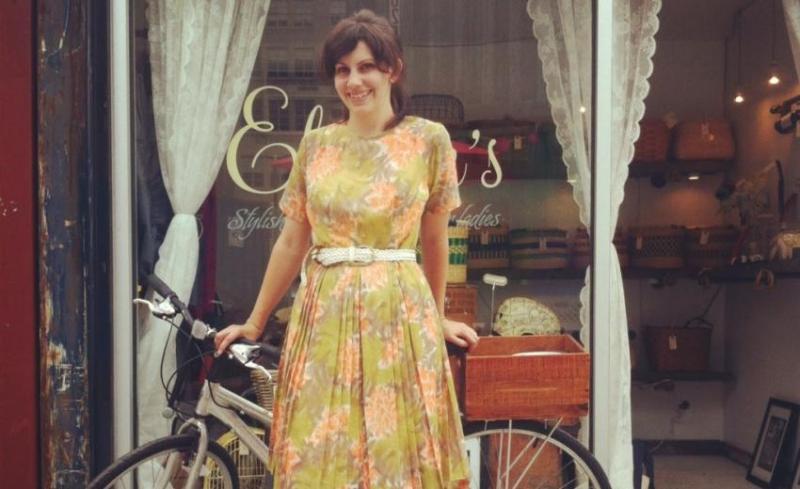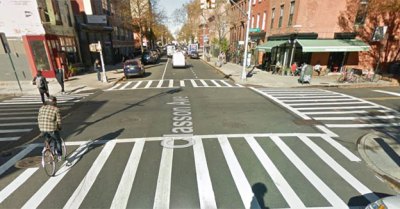Instead of a Classon Avenue Bike Lane, Bed-Stuy Electeds Want a Street Where No One Rides Bikes
City Council Member Robert Cornegy, State Senator Velmanette Montgomery, and Assembly Member Tremaine Wright say that adding some stripes and stencils goes too far. Borough President Eric Adams, meanwhile, says the project should proceed.

On Thursday, DOT announced plans to paint a bike lane on Classon Avenue, the northbound one-way street where a left-turning driver killed Lauren Davis as she rode her bike to work last April. As bicycle infrastructure goes, it’s the bare minimum — some stripes and stencils to designate space for biking, with no changes to moving lanes or parking. But that hasn’t stopped a group of local officials from coming out against it.
The project is set for installation this summer, DOT Brooklyn Borough Commissioner Keith Bray said in a April 11 letter obtained by DNAinfo [PDF]. On most blocks, a new stripe of thermoplast will divide what is now a 13-foot parking lane into a five-foot bike lane and eight-foot parking lane. Blocks that have two travel lanes will only get sharrows:

Nearly 6,000 people signed a petition from Davis’s family asking for a bike lane on Classon Avenue. Now that DOT is moving forward with the new stripes, three elected officials are trying to block it.
In a June 12 letter rife with errors and misinformation, Council Member Robert Cornegy, State Senator Velmanette Montgomery, Assembly Member Tremaine Wright, and CB 3 chair Richard Flateau informed DOT Commissioner Polly Trottenberg of their “significant opposition” to the project.
It’s hard to find a single factual statement in the entire letter, which begins with the assumption that “the decision to convert the existing lane into a conventional bike lane on the west side of the street will not increase safety but will in fact cause additional fatalities.” They go on to argue that the painted lane will “slow down cars,” “impede… timely delivery of goods and services,” and result in “a deleterious impact on economic development.” Of course, no real world examples of the link between bike stencils and economic decline are cited.
Apparently, nothing less than a bicycle-free street will satisfy the signatories. Since Bedford Avenue, Franklin Avenue, Marcy Avenue, and Tompkins Avenue have bike lanes, they argue that the area has a shortage of north-south routes where commercial vehicle drivers can “avoid cyclists.”
“As elected officials who are charged with supporting the needs of all constituents (bicyclists and motorists),” they continue, “we cannot and will not support one group over another.” At least there’s an inadvertent truth buried in there — opposing these basic safety improvement benefits nobody.
“We understand and sympathize with the on-going loss the Davis family is experiencing,” they conclude. “However, DOT needs to think of other ways to keep bikers safety other than instituting a quick fix.” As for what those “other ways” might be, don’t bother looking for specific, usable ideas from this letter.
The Classon Avenue bike lane does have the backing of Borough President Eric Adams, who declared his support for the project last week.
Meanwhile, Lauren Davis’s family continues to seek some measure of accountability for the driver who struck and killed her.
The initial NYPD crash report incorrectly claimed Davis was riding against the direction of traffic, effectively blaming her for her own death. The report was eventually amended to reflect the culpability of the driver, Jennine Chung. But a judge at Chung’s initial DMV safety hearing only had the incorrect, victim-blaming police account. The NYPD officer assigned to the case failed to show up to correct the record.
He came to the follow-up hearing last week, but the DMV judge adjourned the proceedings because Chung’s lawyer was not present, scheduling the next hearing for May 2018, according to Lauren’s sister, Danielle. It could be years before Chung faces any repercussions for killing Lauren Davis, which could take the form of either a license suspension or revocation.
“I am very disappointed and frustrated,” said Danielle Davis. “It feels like invisibility is the only form of representation Lauren deserves in the eyes of the judicial system.”
